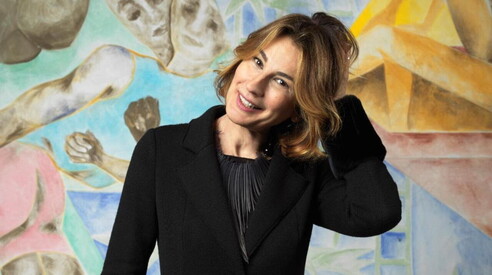Laura Valente: "Millennium Naples" celebrates San Gennaro, the Fringe Festival, Eduardo and Croce


odd faces
With the "Napoli 2500" project, culture and collective memory are celebrated by the sea. Six evenings of music to rediscover the city that tells its story to the world, between its past and new identities.
On the same topic:
There is a lighthouse, and there is a statue that stands out as the first or last image in the memory of those who arrive in Naples or leave it by sea: San Gennaro blessing, greeting tourists and holidaymakers from the Molo San Vincenzo as he greeted the ships of emigrants. who were sailing towards America. Strange as it may seem, no one except a few insiders had set foot in that remote and emblematic place, despite its frequented sights, until July 28th, when the Pier became a stage on the water. For six evenings, a musical program graced the sunsets before an audience of six hundred people, who had free access until August 2nd. This, like many corners of a city that both flaunts and conceals, was opened for "Napoli 2500," the project celebrating Partenope's anniversary with the intention of showing it all off. The director Laura Valente is the cultural manager delegated by Mayor Gaetano Manfredi to the celebrations promoted by the Municipality in collaboration with over seventy organizations, institutions, associations, and museums.
Will the San Vincenzo Pier reopen?
“Al Faro Festival” has all the makings of a regular event. This is the philosophy of the entire “Napoli 2500” program: not a series of commercials, but a legacy for whoever comes after. The Molo San Vincenzo symbolizes Naples's relationship with the world, its culture, which has never imploded because it has given and received from everyone. I've always associated the lighthouse with Enrico Caruso, who rose to prominence in New York and returned to Naples to die. Before the opening performance, we turned off all the lights for ten seconds and listened in silence to the murmur of the sea, which those who emigrated carried in their souls as a memory. I was moved by a small episode: an elderly gentleman who came with a trumpet turned toward the sea and sang “Amapola.” He told me he was fulfilling a lifelong wish.
How did you inaugurate the “Napoli 2500” celebrations?
On March 25th, at the San Carlo, there was a screening of Eduardo De Filippo's "Napoli milionaria!", which was broadcast on television in 1962 and premiered in March 1945 at that very theater, which remains an unknown place to many Neapolitans. It was a thrill to see people entering for the first time: an opportunity to rediscover a community's sense of identity and make everyone understand that they are part of the same, long-lasting story. Manfredi wanted an open and participatory program.
It does not correspond to the widespread perception of the cold engineer mayor.
On the contrary, he prioritized engagement. For example, he enthusiastically embraced the idea of a Fringe Festival, remembering the impressions he had as a boy at the Edinburgh Festival. So, starting this year, Naples finally has a Fringe, which opened in May and will run until December 21st. The City's call for proposals received over 350 proposals, including from abroad, with 600 artists and professionals, and 72 curtain raisers throughout the city: music, dance, theater, visual arts, and a twinning with the Milan and Turin Festivals. We accomplished everything with a budget of €250,000, also including longer residency projects in iconic locations around the city, such as Parco Vergiliano in Piedigrotta, Monte Echia, and the Real Albergo dei Poveri, where courses and workshops were held for creative writing, the production of a cartoon, a film retrospective, and the translation of the Constitution into Neapolitan.
Among the many figures who have contributed to Partenope's history, there are many Neapolitans by adoption. Who will you celebrate?
In October, we will produce Alessandro Scarlatti's oratorio "The Rose Garden," which will be performed at the Girolamini complex on the 300th anniversary of his death . We also sponsored the Chinese translation of Croce's "Neapolitan Stories and Legends" together with at the Italian Embassy, the Benedetto Croce Library Foundation, and the Suor Orsola Benincasa University. The work will be published by China's leading publishing house, and an Arabic translation is also planned. Another initiative focuses on forgotten women, Neapolitan or those who worked in Naples: from feminist artist Lina Mangiacapre to Vittoria Titomanlio, elected to the Constituent Assembly; from Maria Teresa De Filippis, the first female Formula 1 driver, to Saint Joan Antida Thouret, who gathered wayward girls from the historic center to educate them and even taught them French.
She's not Neapolitan either.
I'm Milanese, but I've lived in Naples for almost thirty-six years, and I thank this land for giving me the opportunity to feel like a child of its own. Anyone who engages with Naples becomes a child of its own, and every visitor will be our narrator: we stake our future on the gaze and perception of others. And while it's never true that one person is worth one, because each person is as unique as their fingerprints, it's the sense of community that brings us all together . When we organized an open class on April 29th, for International Dance Day, Piazza Plebiscito was transformed into the largest hall in the world with around three thousand participants. Very few of them knew that the first Italian dance school was founded right here, at the San Carlo, in 1812. It is through knowledge that an identity is built and consolidated.
More on these topics:
ilmanifesto




